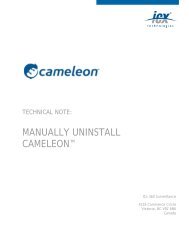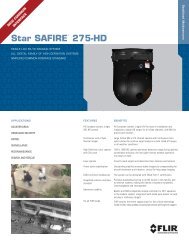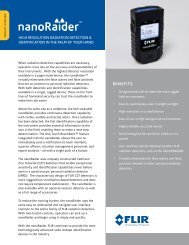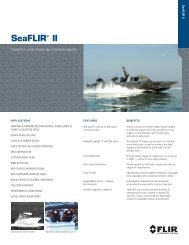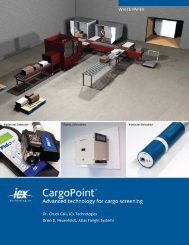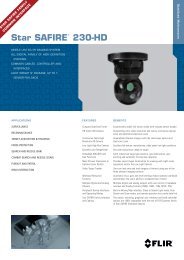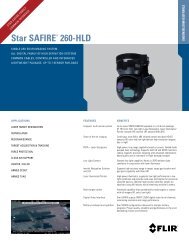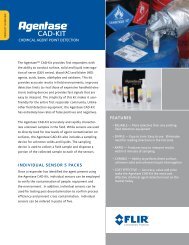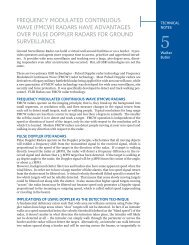BEYOND THE FENCE: - FLIR.com - FLIR Systems
BEYOND THE FENCE: - FLIR.com - FLIR Systems
BEYOND THE FENCE: - FLIR.com - FLIR Systems
Create successful ePaper yourself
Turn your PDF publications into a flip-book with our unique Google optimized e-Paper software.
FUNCTIONAL DESIGN REQUIREMENTS• Detection Zones• External to Perimeter• At Perimeter• Internal to Perimeter• Detection Levels• Linear Detection• Volumetric Detection• Alarm Assessment• Intruder Characteristics• Size• Target Speed• Level of Redundancy (Points of Failure)• Collection of Usable Evidenceproperty is developed in segments. As with many sites,an investment in security assets is made for the externalperimeter in order to optimize future growth anddevelopment.Surrounding the facility, is a heavily vegetated area;very rugged terrain in the form of a ravine that crossesthrough the perimeter; a large flat area that, as a designscenario, is presumed to be a public beach; an abuttingwaterfront that has a jetty for transportation of shipbasedcargo; a port container terminal; and separateindustrial developed areas.DESIGN APPROACHESWith any system design there are two primary approachesto sensor installation design: a feature-based approachand a performance-based approach. The premise of thisstudy focuses on examining the differences in value betweenthese two approaches and what it means to definefeatures as opposed to defining performance.A feature-based approach can be conceptualized as asolution which concentrates on the inclusion of specificaspects – certain systems, procedures, or technologies.Examples of this approach would be requiring CCTVcameras along a perimeter, installing fingerprint readersat all gates and doors in a facility, or installing afiber-based sense detection system. It is quite <strong>com</strong>monto have an organization engaged by a new technologyand make the decision that it needs to be deployedsomewhere in their facility. This is not the best approachto the situation. Often when this happens, atechnology is fit into an application where there maybe overlapping aspects of value while not necessarilycovering all the security requirements.A performance-based approach is focused on evaluatingthe particular security problem and what systemperformance characteristics must achieved. Once theproblem is defined, a measureable functional metric isassociated. Conceptually, rather than stating a requirementfor perimeter cameras, a security official wouldexpress a need for a two-tiered security system to detectboth outside and inside a perimeter. Other criteriamay include observing targets away from the fence-lineor the ability to record evidence at a certain thresholdto provide situational awareness and post-incident reconstructionto support evidentiary needs. This type ofapproach is designed to solve a problem, not to apply ofa specific technology.TECHNOLOGY CONSIDERATIONSIn addition to functional design requirements, thestudy has a significant focus on technology considerations.Each technology is evaluated to determine howand where they are best used and how effective they arein their various applications. In regards to sensor types,specific questions were asked: Are they passive or active?Do they follow the terrain or are they occludedand require a line of sight? Are they designed to lookat large areas or are they very point specific? In regardsto cameras, the different types of capabilities wereevaluated (color, day/night, thermal, etc) in respect tospecific applications. In addition, an extensive analysisof video analytics was performed along with specific,associated design criteria.CAMERA SELECTION AS AN IMPORTANTPROCEDUREA general statement can be made that there is a realmisconception on how cameras work and particularlyhow effective they are. In actuality, a camera only has avery limited field of view.Within that field of view is a diverse array of capabilities.The military distinguishes the effectiveness ofa camera’s capabilities into four categories: detection,classification, recognition, and identification. Thesecategories are described in the following figure.Throughout the field of view of the camera, its capa-8 9
BENCHMARKING CRITERIA• Sensor Performance• Type of Coverage• Probability of Detection• Vulnerability to Defeat• Advance Warning Capacity• Nuisance Alarm Rate• System Performance Characteristics• Level of Detection• Detection• Classification• Recognition• Identification• Alarm Assessment Capability• Multi-Target Engagement Capability• Robustness• Evidence Collection• Cost of Ownership• Initial• Operation and Maintenancebilities vary considerably based on the characteristicsof the camera <strong>com</strong>ponents. To make cameras workwell, a <strong>com</strong>plicated engineering analysis is required.Understanding how cameras work is very critical tooptimizing site design. In many applications, camerasare simply thrown at the perimeter and security officialsend up disappointed with the technology, because,though the cameras are doing what they are capable of,they haven’t been applied correctly.DESIGN SCENARIOS FOR THIS STUDYAs a part of this study, four design scenarios wereestablished, optimized and <strong>com</strong>pared. Scenario Onehad a medium asset value and was developed with afeature-based approach. This system focused on CCTVapplications with no external perimeter coverage. Therest of the scenarios utilized a performance-basedapproach to optimize the solution. Scenario One wasdesigned primarily for <strong>com</strong>parison purposes.Scenario Two was considered to have a medium assetvalue. No external perimeter coverage, volumetriccoverage or redundancy was included. Scenario Threeincreased the asset value and provided external to perimeter/volumetriccoverage and redundancy throughan optimized, layered approach. Finally, Scenario Fourwas considered to have the highest asset value and maximumsecurity criteria for a <strong>com</strong>prehensive solution.The scenarios escalate in terms of the value assets, thecapital value of the assets and also the performancerequirements. The presumption was that as asset valueincreases so too did the performance characteristicsthat were expected to be achieved.DESIGN SCENARIOSScenario One was used as a benchmark to show howtechnology is normally applied and the associated cost.With a progressively escalating asset value from ScenariosTwo to Four, asset value was used as a key indexdue to the fact that it can be easily conceptualized andhelps drive the optimization of a solution.SCENARIO 1 – MEDIUM VALUE(CCTV COVERAGE)In this scenario, a standard value asset is located in themiddle of the perimeter. The goal was to use CCTVcoverage along a fenced perimeter around the facilityin order to achieve visibility along the perimeter itself.From a client’s perspective, this is essentially findingout what is happening at the perimeter in order to stopor deter an intruder from cutting the fence or breakingin. Though not a particularly sophisticated approach,Scenario One was used as a benchmark in terms ofcosting and layout.As can be seen, fixed cameras are laid out along theperimeter with various colors depicting the detection,recognition and identification zones for a particularcamera. At key points, specifically the corners of thefacility, pan, tilt, zoom cameras are able to assist withinterdiction of identified intruders and overall increasedsurveillance.SCENARIO 2 – MEDIUM VALUE(OPTIMIZED SOLUTION)Scenario Two includes similar types of assets with thesame value and still classified as medium. However,a slightly more sophisticated solution was installed.Rather than a client asking to apply cameras along theperimeter, this solution detects what is going on alongthe perimeter. This solution includes point-based,fence-bound intrusion detection. CCTV cameras withpan, tilt, zoom functionality are strategically located onthe corners of buildings and around the gates to enhancedetection and recognition.SCENARIO 3 – HIGH VALUE(OPTIMIZED SOLUTION)Scenario Three, this is where the solution begins to getmore sophisticated. In this scenario the asset value andperformance criteria have been increased. The resultis the ability to extend perimeter coverage beyond the10 11
FUNCTIONAL COMPARISON MATRIXThe result of this study was a cost and performance <strong>com</strong>parison matrix. For the most part, asthe value and performance requirements increased, so too did actual capital costs. There wasone notable exception to this increase.In our simplest, feature-based scenario, the total system cost came to approximately $2.3 million(USD). Interestingly, in Scenario Two a similar, but much more optimized solution was achieved.However, that scenario resulted in a significant drop in capital cost. Scenario Three, which was amuch higher value asset than Scenario One, but offered an optimized design solution with considerablyincreased functional requirements, actually resulted in a capital cost not that much higher.Finally, most notably, the high value asset in Scenario Four predictably resulted in a much highercapital cost.SYSTEM PERFORMANCEAdditionally, system performance characteristics followed a similar pattern. Increasing levels ofsophistication and capability, still with Scenarios One and Three costing approximately equivalent.SENSOR PERFORMANCEAcross the scenarios different types of performance characteristics can be seen with a correspondingincreasing capability level. Significantly, in Scenario One, which doesn’t have a veryfavorable evaluation, it costs just about the same as Scenario Three which has a significantlyimproved capability across the various performance matrices.14 15
KEY EVALUATION OF FINDINGS – CONTRAST SCENARIO 1 & 3The following tables summarize the cost and performance <strong>com</strong>parison for Scenarios One andThree (a features-based approached versus a performance-based approach). The result was a minorcost differential, but a fairly major difference in the system capabilities.NEXT STEPSIt’s clear to see that the functional requirements anda performance-based approach offer quite a bit bettervalue. Although this may seem like an obvious conclusion,and possibly simplistic given the steps undertakenin this study, in reality the feature-based approach isapplied much more often than the performance-basedapproach. There are likely several factors for this. Oneattributing factor is that technology changes very rapidlyand it is very difficult, even for engineers, to keepup with how new technology performs, how it shouldbe applied and the details around implementation.This factor is magnified for someone who doesn’t havea technical background, but is yet charged with theresponsibility of implementing a very large securitysystem. Many people have fallen prey to salesmen who<strong>com</strong>e in with the latest and greatest technology, whichmay in fact be a very good technology, but without anunderstanding of its plausibility within their currentsystem.It is very clear that focusing on and articulating theproblem and requirements is a mission critical step. It’sextremely important to understand what exactly therequirements a system must achieve. <strong>FLIR</strong> and PBAhave taken a phased approach to project assessmentand development in what we’ve termed the Phase 1 siteassessment. It is essentially a needs analysis and preliminarydesign. Because often times project planners willproceed with information, particularly costing information,which is not as <strong>com</strong>prehensive as it should be.Once a project is in motion, facility security managersare required to reduce the scope or goal of the project tomeet budget requirements. When cost is appropriatelyaddressed up front and a thorough site assessment andpreliminary design performed, site officials are able toproceed in an informed manner, knowing their designrequirements are supportable.Clearly defining requirements, making sure they applycorrectly to the site, then developing a preliminary designand preliminary architecture is absolutely essential.Through this process costs can be derived and a clearsummary report developed. This provides supportingdocumentation that, in turn, provides the justificationof costing. Simply put, it’s much easier to gain buy inwhen a proposed project can be fully supported. Thisinformation also allows the project team to proceed inan informed manner. From here, detailed design andimplementation follow naturally.KEY FINDINGS1. Understanding the functional requirementsis very important2. Identify the problem before the solution3. Performance based approach offersbest value4. Optimized solutions blend technologies tosolve problems16 17



